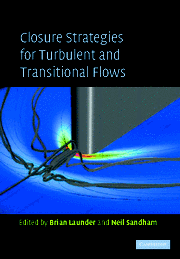Preface
Published online by Cambridge University Press: 06 July 2010
Summary
Material for this volume first began to be assembled in 1999 when a six-month Programme on Turbulence was held at the Isaac Newton Institute for Mathematical Sciences in Cambridge. The Programme had its own origins in an Initiative on Turbulence by the UK Royal Academy of Engineering, which had identified the prediction of turbulent flow as a key technology across a range of industrial sectors. Researchers from different disciplines gathered together at the Newton Institute building in Cambridge to work on aspects of the turbulence problem, one of the most important of which was closure of the averaged (or filtered) turbulent flow equations. An InstructionalWorkshop on Closure Strategies for Modelling Turbulent and Transitional Flows was held from April 6 to 16th. The aim of the workshop was for the experts on closure to present material leading up to the current state-of-the-art in a form suitable for research students and others requiring a broad overview of the field, together with an appreciation of current issues. A sequence of 38 lectures by 19 different lecturers provided background to techniques, examples of current applications, and reflections on possible future developments. Recognising that a gathering of so many experts from a variety of backgrounds was somewhat unusual, it was felt that a more polished version of the lecture material would be of interest to a wider audience, as a reflection upon the current state of prediction methods for turbulent flows. The result has taken rather longer to appear than originally intended, but the opportunity has been taken for contributions to be updated wherever possible, to take account of the most recent developments.
The Editors would like to thank the contributors for their efforts to improve the papers, with a view to making them more accessible to the intended audience, which remains that of the original workshop. Especial thanks are due to Dr T. Gatski who shouldered the not inconsiderable task of shaping three separate contributions into a single chapter on compressible flow. Thanks are also due to the Newton Institute for hosting the workshop, and the main sponsors of the Turbulence Programme, including the then British Aerospace (now BAE Systems), Rolls–Royce, The Meteorological Office, British Gas Technology, British Energy, and the UK Defence Evaluation Research Agency. Finally we record our appreciation to Mrs C. King who provided invaluable secretarial support throughout theWorkshop and in the editing of the present volume.
Information
- Type
- Chapter
- Information
- Publisher: Cambridge University PressPrint publication year: 2002
